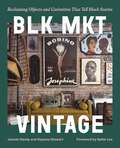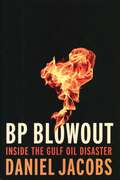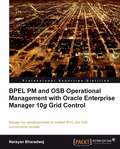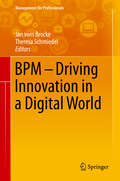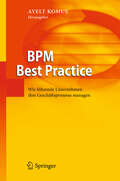- Table View
- List View
BLK MKT Vintage: Reclaiming Objects and Curiosities That Tell Black Stories
by Jannah Handy Kiyanna StewartThis one-of-a-kind treasure trove of Black cultural ephemera, from the entrepreneurs behind the vintage shop BLK MKT Vintage, expands on their mission to curate vintage objects that tell Black stories and celebrate the contributions Black people have made to our American consciousness. Jannah Handy and Kiyanna Stewart have spent years scouring piles, stacks, bookshelves, and dilapidated boxes in search of themselves and their history, Black history. Through their Brooklyn brick-and-mortar BLK MKT Vintage and online shop, they have uncovered tens of thousands of items including vintage literature, vinyl records, clothing, art, decor, furniture and more. BLK MKT Vintage: Reclaiming Objects and Curiosities That Tell Black Stories invites readers into Handy and Stewart&’s work and partnership as they pick, collect, curate, design, and reimagine futures for the objects of the past. Brimming with more than 300 photographs of vintage pieces of ephemera, the book is a beautiful, ephemeral object itself calling to mind a scrapbook or family album that has a surprise on every page whether that&’s 1972 celluloid pins from Shirley Chisholm&’s presidential campaign, early 1800&’s hand-drawn maps of the African continent, or 1920&’s bound yearbooks from various HBCUs. The book also explores the various concepts that ground Handy and Stewart&’s work; interviews with Black archivists, artists, memory workers and collectors – including a foreword from Spike Lee; a look into their private collection of thousands of items they have discovered over the years; an explanation of the different players in the antiques and vintage world; and tips and tricks on how to begin your own collection and curate physical spaces that reflect your identity and experience.
BLOGANDO: O Guia Mais Engenhoso Para Começar um Blog Remunerador
by Talis Ramalho Barboza Isaac KronenbergAssim, este livro tem o objetivo de revelar à você exatamente o que os grandes blogueiros de sucesso fazem. Claro, eu sei que você já ouviu essa história antes, apenas pegue o nicho certo, escreva bons artigos, espalhe links de afiliados em todos os lugares, e com certeza você terá lucros. Bem, eu tenho novidades para você! NÃO é assim que os grandes blogueiros de sucesso estão fazendo! Embora, há alguma verdade nisso, você deve por links de afiliados no seu blog, mas apenas espalhar eles por aí esperando que alguem clique é uma estratégia totalmente errada. Portanto, este livro te revela exatamente o que os grandes blogueiros de sucesso realmente fazem (que é exatamente o que eu faço). Não tenha dúvidas sobre isso, a maioria das pessoas que entra no mundo dos blogs não tem noção alguma sobre monetização, e falham em transformar o blog numa renda. E já que essa é a realidade das coisas, sua competição é muito baixa se você fizer as coisas certas, utilizando o método que eu descrevo neste livro. De fato, você nunca vai precisar ler outro livro sobre blogs depois que este aqui passar nas suas mãos, porque você vai saber exatamente o que você precisa fazer para gerar uma renda utilizando o seu blog. Confie em mim nisso, este livro é o melhor livro sobre blogs que você vai ler na sua vida, e ele vai te mostrar um caminho bem certeiro para que você seja pago através do seu blog. O único jeito de falhar é se você não implementar os métodos que eu ensino, então certifique-se de ler este livro com calma, e implemente o método que eu descrevo para você, porque eu tenho certeza que isso vai elevar o seu blog para o próximo nível.
BMG Entertainment
by Jan W. Rivkin Gerrit MeierAs dramatic changes in technology and customer tastes roil the music industry, the top executives of BMG Entertainment, one of the world's largest record companies, must decide how to organize for digital distribution of music. This case includes a brief history of the music industry, a description of the industry's current structure and economics, and a description of digital downloading efforts.
BMVSS: Changing Lives through Innovation One Jaipur Limb at a Time (Abridged)
by Srikant M. Datar Saloni Chaturvedi Caitlin N. BowlerBhagwan Mahaveer Viklang Sahayata Samiti (BMVSS) is an Indian not-for-profit organization engaged in assisting differently-abled persons by providing them with the legendary low-cost prosthesis, the Jaipur Foot, and other mobility-assisting devices, free of cost. Known for its patient-centric culture, its focus on innovation, and for developing the $20 Stanford-Jaipur knee, BMVSS has assisted over a million people in its lifetime of 44 years. As the founder, Mr. D.R. Mehta, thinks about the financial sustainability of BMVSS, he must devise a strategy that will sustain its human impact well into the future.
BMVSS: Changing Lives, One Jaipur Limb at a Time
by Srikant M. Datar Saloni ChaturvediBhagwan Mahaveer Viklang Sahayta Samiti (BMVSS) is an Indian not-for-profit organization engaged in assisting differently-abled persons by providing them with the legendary low-cost prosthesis, the Jaipur Foot, and other mobility-assisting devices, free of cost. Known for its patient-centric culture, its focus on innovation, and for developing the $20 Stanford-Jaipur knee, BMVSS has assisted over a million people in its lifetime of 44 years. As the founder, Mr. D.R. Mehta, thinks about the financial sustainability of BMVSS, he must devise a strategy that will sustain its human impact well into the future.
BMVSS: Changing Lives, One Jaipur Limb at a Time
by Srikant M. Datar Saloni ChaturvediBhagwan Mahaveer Viklang Sahayta Samiti (BMVSS) is an Indian not-for-profit organization engaged in assisting differently-abled persons by providing them with the legendary low-cost prosthesis, the Jaipur Foot, and other mobility-assisting devices, free of cost. Known for its patient-centric culture, its focus on innovation, and for developing the $20 Stanford-Jaipur knee, BMVSS has assisted over a million people in its lifetime of 44 years. As the founder, Mr. D.R. Mehta, thinks about the financial sustainability of BMVSS, he must devise a strategy that will sustain its human impact well into the future.
BMW AG: The Digital Auto Project (A)
by Stefan Thomke Ashok NimgadeDescribes how the German automotive firm BMW is trying to reduce its development time by half with the aid of computer-aided technologies. To leverage these technologies fully in the very competitive automotive industry, BMW is faced with the challenge of changing its processes and organization, gradually building new development capabilities. This tension between the old and the new is played out in BMW's design area, which has historically been responsible for much of BMW's strategic product positioning. Focuses on: 1) managing automotive development, with an emphasis on exterior styling; 2) new computer-aided technologies and their potential impact on development performance; and 3) the organizational and process changes required to gradually build a firm's development capability.
BMW's Project Switch (A): Importers vs. National Sales Companies
by Das Narayandas Kerry HermanBMW is faced with potential channel conflicts across several EU country markets. The case highlights BMW's approach to redesigning its channel in Greece. The case provides details on both headquarter and country head perspective on BMW's channel strategy.
BMW: The 7-Series Project (A)
by Gary P. PisanoExplores BMW's decision about how to manufacture prototype vehicles. Historically, BMW's prototypes were handcrafted by highly skilled artisans in the company's shop. A proposal has been made to alter the process so that prototypes are made in a way that can better uncover potential problems that may arise during final production. While the new approach is expected to make production start-up of new models smoother and reduce quality problems, there is some concern within the company that it will lead to less flexibility to change (and improve) designs during the development cycle. Explores different ways of competing on quality in a luxury product segment and how the product development process affects each of these. A second objective is to examine the notion of a prototyping strategy and the role prototyping plays in linking development strategy and manufacturing strategy.
BMW: The Ultimate Driving Machine Seeks to De-Yuppify Itself
by Stephen A. Greyser Wendy SchilleTracks changes in the luxury auto market during the 1980s and early 1990s. Shifts in target consumer behavior--particularly the yuppie lifestyle--serve as the basis for manufacturer modifications of product line, positioning, and advertising. The climax of the case is the 1991 overt effort by BMW to "de-yuppify" itself in the minds of the target market.
BMWFilms
by Youngme Moon Kerry HermanJim McDowell, VP of marketing at BMW North America, is debating how to follow up the success of his latest marketing campaign, "BMWFilms." This campaign features five short films for the Internet, directed by some of the hottest young directors in Hollywood. By all indications, the nontraditional campaign has been a huge success. Now the question is, what to do for an encore?
BOC Group: Ohmeda (A)
by Rowland T. Moriarty Jr. Gordon SwartzThe president of Ohmeda, a wholly owned company of the BOC Group, plans to grow the company's medical equipment sales from $95 million in 1985 to $158 million in five years by focusing on the sale of "high-tech" equipment. At the same time, the president expects to sell Ohmeda's medical supplies business ($22 million in sales) and to transfer its medical gases business ($27.2 million in sales) to another business unit of the BOC Group. The changes in Ohmeda's products combined with the planned growth in medical equipment cause the president to reassess Ohmeda's marketing system. The new strategic thrust requires him to review the role of Ohmeda's direct sales and dealer sales coverage. In doing so he evaluates the economics of three options: 1) continuing with Ohmeda's present system, 2) eliminating dealer sales coverage, and 3) specializing salespeople by product group.
BP Amoco (A): Policy Statement on the Use of Project Finance
by Michael Kane Benjamin C. EstyFollowing the BP/Amoco merger in December 1998, CFO David Watson asked Bill Young to recommend when and under what circumstances the firm should use external project finance instead of internal corporate funds to finance new capital investments. As part of this assignment, Young and his team must review each firm's current policy regarding project finance and evaluate the various rationales used to justify its use. Following this review, his team created a new policy statement recommending that BP Amoco finance capital expenditures using corporate funds except in three special circumstances: mega projects, projects in politically volatile areas, and joint ventures with heterogeneous partners. Whether the general rule of using corporate funds and whether the specific exceptions to the rule are appropriate for the merged entity are subjects for class discussion.
BP Amoco (B): Financing Development of the Caspian Oil Fields
by Michael Kane Benjamin C. EstyBritish Petroleum and Amoco were the two largest members of the Azerbaijan International Oil Consortium (AIOC), an 11-firm consortium that was spending $10 billion to develop oil fields in the Caspian Sea. As of March 1999, AIOC had completed a $1.9 billion development project known as Early Oil. The two companies, however, had financed their shares of this project in different ways: BP used internal funds (traditional, on-balance sheet corporate finance), whereas Amoco was one of five AIOC partners that raised $400 million of project finance. Following the BP/Amoco merger in December 1998, managers in the combined firm's finance group had to reassess the Early Oil financing strategy and determine the best way to finance its share of the $8 billion Full Field Development Project. Should it use internal funds, project finance, or a mixture of the two?
BP Blowout: Inside the Gulf Oil Disaster
by Daniel JacobsBP Blowout is the first comprehensive account of the legal, economic, and environmental consequences of the 2010 oil disaster in the Gulf of Mexico. The accident destroyed the Deepwater Horizon oil rig and killed eleven people. The resulting offshore oil discharge, the largest ever in the United States, polluted much of the Gulf for months, wreaking havoc on its inhabitants.A former Justice Department lawyer responsible for enforcing environmental laws, Daniel Jacobs tells the story that neither BP nor the federal government want heard: how the company and the government fell short, both in terms of preventing and coping with the accident.All-important details about the cause and aftermath of the disaster have emerged through court proceedings and with the passage of time. The key finding of the federal judge who presided over the civil litigation arising out of the disaster was that the Deepwater Horizon blowout resulted from BP's gross negligence.BP has paid tens of billions of dollars to settle claims and lawsuits arising from the accident. The company also has pled guilty to manslaughter in a separate criminal case. Yet, no one responsible for the accident itself is headed to prison. On the other hand, hundreds of people have been prosecuted for filing false claims against BP, some seventy-five of whom have been sentenced to prison.BP Blowout is an important book for readers interested in the environment, sustainability, public policy, leadership, and the consequences of poor risk management.
BP and the Consolidation of the Oil Industry--1998-2002
by Forest Reinhardt Ramon Casadesus-Masanell David J. HansonExamines the economics of the oil and gas industry with a focus on 1998 through 2001. Discusses the rationale behind using a growth in scale as a means to increase profitability and to gain competitive advantage. Also examines the classic strategic implications of vertical integration and questions the necessity of remaining vertically integrated in today's markets. During 1998-2001, the industry structure changed dramatically with the occurrence of a wave of merger activity. Set at the end of 2001, as BP's chief executive, Lord John Browne, ponders the company's future. BP set off the merger activity in 1998 with its combination with Amoco. Other major oil concerns quickly followed suit. Several large and dominant firms, termed "supermajors," separated themselves from the rest of the competitors. Although a large number of independent specialty firms also exist, the supermajor firms no longer believe them to be direct competitors. After the case discussion, students should be able to: 1) understand the basic economics of the oil and gas industry, 2) analyze the rationale behind vertical integration strategies, 3) analyze why the industry restructuring occurred, and 4) understand the economies of scale of the supermajor firms as well as the potential problems their immense size could create.
BP and the Consolidation of the Oil Industry: Supplement
by Forest Reinhardt Nazli Z. Uludere AragonAn abstract is not available for this product.
BP's Macondo: Spill and Response
by Julio J. RotembergThis case starts by reporting various factors that may have contributed to the massive Macondo oil spill, noting that BP, its partners, and the government all made decisions that helped cause the accident. It then discusses the response to this spill by BP and the government. This helps provide some context for the decision by the Obama administration to request $20 billion for a fund from BP and for BP's willingness to go along with this request. The case also depicts BP's safety record before this spill, which may also have contributed to the creation of this fund. After this, the case describes the various ways in which the U.S. government is involved in offshore oil, including the leasing of tracts, the regulation of drilling, and the assessment of fines and damages. To provide contrast with BP's payments, the case depicts the payments made by Exxon after the Exxon Valdez spill. The U.S. regulatory regime is then briefly compared with regimes in other countries. After a brief description of the way the fund set up by BP sought to distribute funds and of the temporary moratorium that followed the spill, the case ends with discussion of possible regulatory responses.
BPEL PM and OSB operational management with Oracle Enterprise Manager 10g Grid Control
by Narayan BharadwajThis book is a step-by-step tutorial on how to automate the management of BPEL Process manager, SOA Suite, and Oracle Service Bus. Each chapter has a problem-solution approach, starting with a real-world problem and then providing the solution to the problem using illustrative examples. This book is written for BPEL and OSB administrators who deal with Oracle BPEL Process Manager, Oracle SOA Suite, or Oracle Service Bus in a production environment and who need to automate operational tasks. If you are an SOA architect or associated with SOA governance, this book will serve as an eye opener for the many available features to provide production assurance in complex SOA environments. A general awareness of Service-Oriented Architecture is expected, as well as an awareness of Oracle SOA products such as BPEL Process Manager and Oracle Service Bus. No specific management or operational expertise is required.
BPM - Driving Innovation in a Digital World (Management for Professionals)
by Jan Vom Brocke Theresa SchmiedelThis book shows how business process management (BPM), as a management discipline at the intersection of IT and Business, can help organizations to master digital innovations and transformations. At the same time, it discusses how BPM needs to be further developed to successfully act as a driver for innovation in a digital world. In recent decades, BPM has proven extremely successful in managing both continuous and radical improvements in many sectors and business areas. While the digital age brings tremendous new opportunities, it also brings the specific challenge of correctly positioning and scoping BPM in organizations. This book shows how to leverage BPM to drive business innovation in the digital age. It brings together the views of the world's leading experts on BPM and also presents a number of practical cases. It addresses mangers as well as academics who share an interest in digital innovation and business process management. The book covers topics such as BPM and big data, BPM and the Internet of Things, and BPM and social media. While these technological and methodological aspects are key to BPM, process experts are also aware that further nontechnical organizational capabilities are required for successful innovation. The ideas presented in this book have helped us a lot while implementing process innovations in our global Logistics Service Center. Joachim Gantner, Director IT Services, Swarovski AG Managing Processes - everyone talks about it, very few really know how to make it work in today's agile and competitive world. It is good to see so many leading experts taking on the challenge in this book. Cornelius Clauser, Chief Process Officer, SAP SE This book provides worthwhile readings on new developments in advanced process analytics and process modelling including practical applications - food for thought how to succeed in the digital age. Ralf Diekmann, Head of Business Excellence, Hilti AG This book is as an important step towards process innovation systems. I very much like to congratulate the editors and authors for presenting such an impressive scope of ideas for how to address the challenging, but very rewarding marriage of BPM and innovation. Professor Michael Rosemann, Queensland University of Technology
BPM Best Practice: Wie führende Unternehmen ihre Geschäftsprozesse managen
by Ayelt KomusWie managen führende Unternehmen ihre Geschäftsprozesse? Was sind die Grundlagen des Erfolgs? Basierend auf einer Untersuchung der Business-Process-Management-Praktiken (BPM) in 17 Unternehmen zeigt das Buch, wie in Best-Practice-Unternehmen Organisation und IT-Systeme optimal aufeinander abgestimmt werden, um die Kundenorientierung zu steigern, Kosten zu senken sowie Flexibilität und Qualität zu verbessern. Der Band enthält eine Analyse der Erfolgsmuster, wichtige Umsetzungshinweise sowie einen Ausblick auf zukünftige Entwicklungen des BPM.
BRAC
by John A. Quelch Nathalie LaidlerBRAC is the world's largest NGO and has over the past 20 years experienced tremendous rates of growth. The case looks at diversity within the organization and the aspects of management that have made the organization so successful.
BRAC in 2014
by Tarun Khanna Aldo Sesia Rachna Tahilyani Reeti RoyIn the early 1970s BRAC was a startup nongovernmental organization (NGO) working in Bangladesh. By 2014, it was the world's largest NGO. It had a strong presence in Bangladesh and had begun to deliver social development programs in nine other countries. Its founder and chairperson Fazle Hasan Abed was knighted in 2010 by the British Crown for his service in reducing poverty. The organization took a holistic approach to alleviating poverty, which depended on providing the poor with a portfolio of services including education, agriculture development, healthcare, community empowerment, and microfinance. Around 70% of the funding to deliver BRAc's development programs and services came from its own for-profit social enterprises. The case study allows students to examine the organization's evolution and its business model.
BRAC in 2014
by Tarun Khanna Aldo Sesia Rachna Tahilyani Reeti RoyIn the early 1970s BRAC was a startup nongovernmental organization (NGO) working in Bangladesh. By 2014, it was the world's largest NGO. It had a strong presence in Bangladesh and had begun to deliver social development programs in nine other countries. Its founder and chairperson Fazle Hasan Abed was knighted in 2010 by the British Crown for his service in reducing poverty. The organization took a holistic approach to alleviating poverty, which depended on providing the poor with a portfolio of services including education, agriculture development, healthcare, community empowerment, and microfinance. Around 70% of the funding to deliver BRAc's development programs and services came from its own for-profit social enterprises. The case study allows students to examine the organization's evolution and its business model.
